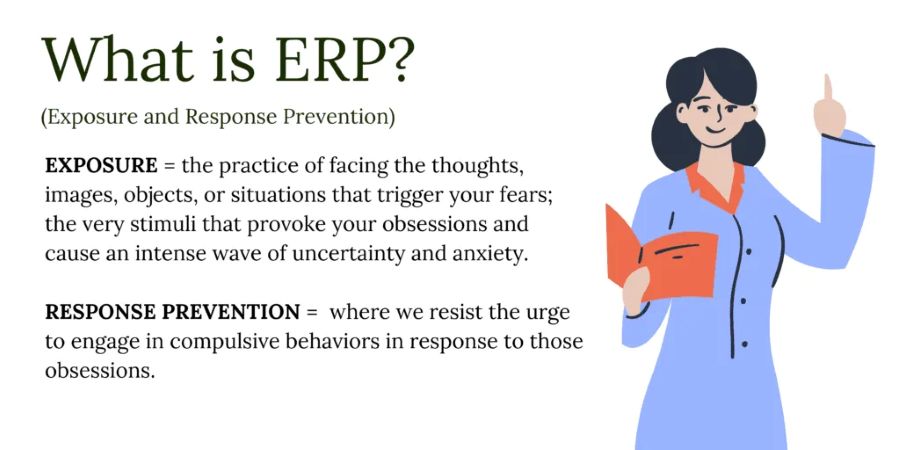Obsessive-Compulsive Disorder (OCD) can be debilitating, but Exposure and Response Prevention Therapy (ERP) is the gold-standard treatment for breaking the cycle of intrusive thoughts and compulsive behaviors. This evidence-based approach, endorsed by the International OCD Foundation and McLean Hospital, empowers individuals to confront their fears in a structured way, reducing anxiety and regaining control over their lives.
What Is Exposure and Response Prevention Therapy?
ERP is a specialized form of Cognitive Behavioral Therapy (CBT) designed specifically for OCD. It involves two essential components:
- Exposure: Gradually confronting situations, thoughts, or objects that trigger anxiety.
- Response Prevention: Avoiding compulsive behaviors that would normally follow the anxiety trigger.
Through repeated exposures, individuals learn that their fear diminishes over time, a process known as habituation. This retrains the brain to stop associating distressing thoughts with immediate action, leading to lasting symptom reduction.
The Core Goals of ERP Therapy
1. Break the OCD Cycle
OCD symptoms follow a cycle: obsessions cause anxiety, leading to compulsions that provide temporary relief but reinforce the obsession. ERP disrupts this pattern by allowing individuals to experience anxiety without acting on compulsions, leading to long-term symptom reduction.
2. Reduce Fear and Anxiety Responses
Exposure to feared thoughts and situations helps individuals develop a new understanding: anxiety naturally fades without compulsions. Over time, fear responses weaken, making intrusive thoughts less overwhelming.
3. Increase Tolerance for Uncertainty
Many people with OCD struggle with needing certainty. ERP teaches individuals that uncertainty is a normal part of life and does not require compulsive reassurance-seeking behaviors.
4. Improve Cognitive Flexibility
ERP encourages a new relationship with intrusive thoughts—viewing them as harmless mental events rather than urgent problems to solve. This shift reduces OCD’s impact on daily life.
5. Restore Functionality
OCD can interfere with work, relationships, and overall well-being. ERP helps individuals reclaim control, allowing them to focus on meaningful activities without compulsions dictating their time.
6. Develop Lifelong Coping Skills
ERP provides lasting skills to manage intrusive thoughts independently. With continued practice, individuals maintain progress and prevent relapse.
Getting treatment for OCD can lead to many improvements in your life and relationships improving your quality of life.
How ERP Therapy Works
ERP follows a structured, research-supported process designed to help individuals safely face fears while resisting compulsions. The steps include:
Step 1: Identifying Triggers
Individuals work with a therapist to create a hierarchy of fears, ranking situations that provoke anxiety from least to most distressing.
Step 2: Gradual Exposure
Starting with lower-intensity triggers, individuals gradually face their fears in a controlled, supportive setting. Over time, they move toward more challenging exposures.
Step 3: Preventing Rituals
Individuals actively resist compulsive behaviors, learning that anxiety decreases naturally without rituals.
Step 4: Repetition and Reinforcement
Consistent exposure leads to habituation, where the anxiety response diminishes, and individuals feel less driven to act on compulsions.
Step 5: Applying ERP in Daily Life
Long-term success comes from applying ERP strategies outside therapy, ensuring individuals can manage OCD triggers in real-world settings.
Find out how other challenges like Gender Dysphoria and Anxiety can intersect with OCD with these articles:
- When Gender and OCD Collide and Understanding the Mental Health Overlap
- OCD and Anxiety: Everything You Need to Know
If you feel like you need help with OCD or other challenges, don’t wait!
Real-World Applications of ERP
To illustrate how ERP works in daily life, here’s an example:
- Case Study: Sarah, a 32-year-old with contamination OCD, avoided touching doorknobs due to fear of germs. In therapy, she started by touching a doorknob and waiting five minutes before washing her hands. Over time, she increased the waiting period until she no longer felt the urge to wash after touching doorknobs. By doing this repeatedly, she reduced her anxiety and broke the compulsive cycle.
- Common Challenges and How to Overcome Them:
- Fear of getting worse before improving: It’s normal for anxiety to increase initially. Therapists help individuals push through early discomfort to see progress.
- Doubt about success: Many worry ERP won’t work for them. However, studies show it has one of the highest success rates among OCD treatments.
- Struggling with motivation: A strong support system, whether through therapy or peer groups, can make a difference.
Individual Therapy is your avenue for healing and improvement and combining it with support groups can make you feel less alone.
The Benefits of ERP in Managing OCD
ERP is recognized as the most effective treatment for OCD, offering lasting relief. Key benefits include:
✔ Reduced Anxiety Levels: Repeated exposure weakens fear responses, reducing anxiety over time.
✔ Greater Emotional Resilience: Individuals develop confidence in managing uncertainty without compulsions.
✔ Improved Decision-Making: ERP helps individuals rely on personal values rather than fear-driven behaviors.
✔ Enhanced Quality of Life: By reducing OCD’s grip, individuals can focus on relationships, work, and personal goals.
✔ Sustained Progress: ERP provides long-term tools for managing symptoms, minimizing relapse risks.
How ERP Compares to Other OCD Treatments
While ERP is the leading treatment for OCD, other approaches can complement it, including:
- Medication (SSRIs): Often used alongside ERP to reduce symptom intensity.
- Acceptance and Commitment Therapy (ACT): Helps individuals accept intrusive thoughts without judgment.
- Mindfulness Techniques: Can improve emotional regulation and reduce stress levels.
Adding these elements to ERP can further enhance long-term success.
What to Expect When Starting ERP Therapy
Beginning ERP can be intimidating, but understanding the process makes it easier to commit. Key points to keep in mind:
- ERP is a Proven Approach: Studies show ERP is the most effective treatment for OCD, offering long-lasting results.
- Therapists Provide Structure and Support: Individuals work with trained professionals to progress at a manageable pace.
- Success Happens Gradually: ERP is a process—over time, intrusive thoughts lose their power.
- The Goal is Management, Not Elimination: Everyone experiences intrusive thoughts, but ERP helps individuals react differently to them.
Is ERP Therapy Right for You?
If intrusive thoughts and compulsions interfere with your daily life, ERP could be the key to regaining control. Most individuals who complete ERP experience significant symptom reduction, with long-term benefits.
If you’re searching for specialized ERP therapy in Connecticut or New York City, finding a provider trained in evidence-based OCD treatment is the next step.
FAQs About ERP Therapy for OCD
1. How long does ERP therapy take to be effective?
Many individuals notice improvement within 8-12 sessions, though progress depends on severity and consistency.
2. Can ERP therapy be done online?
Yes, virtual ERP therapy is highly effective and provides accessible treatment options.
3. What if my anxiety increases at first?
It’s normal for anxiety to rise initially. Over time, ERP teaches individuals to tolerate distress without compulsions.
4. Is ERP suitable for children and teens?
Yes, ERP is effective across all age groups and can be adapted for younger individuals.
Your First Step Toward Relief is Here
If OCD is controlling your life, Collaborative Change can help. Our expert therapists specialize in Exposure and Response Prevention Therapy, offering personalized treatment plans to help you regain freedom from OCD. Reach out today to start your journey toward lasting change.


